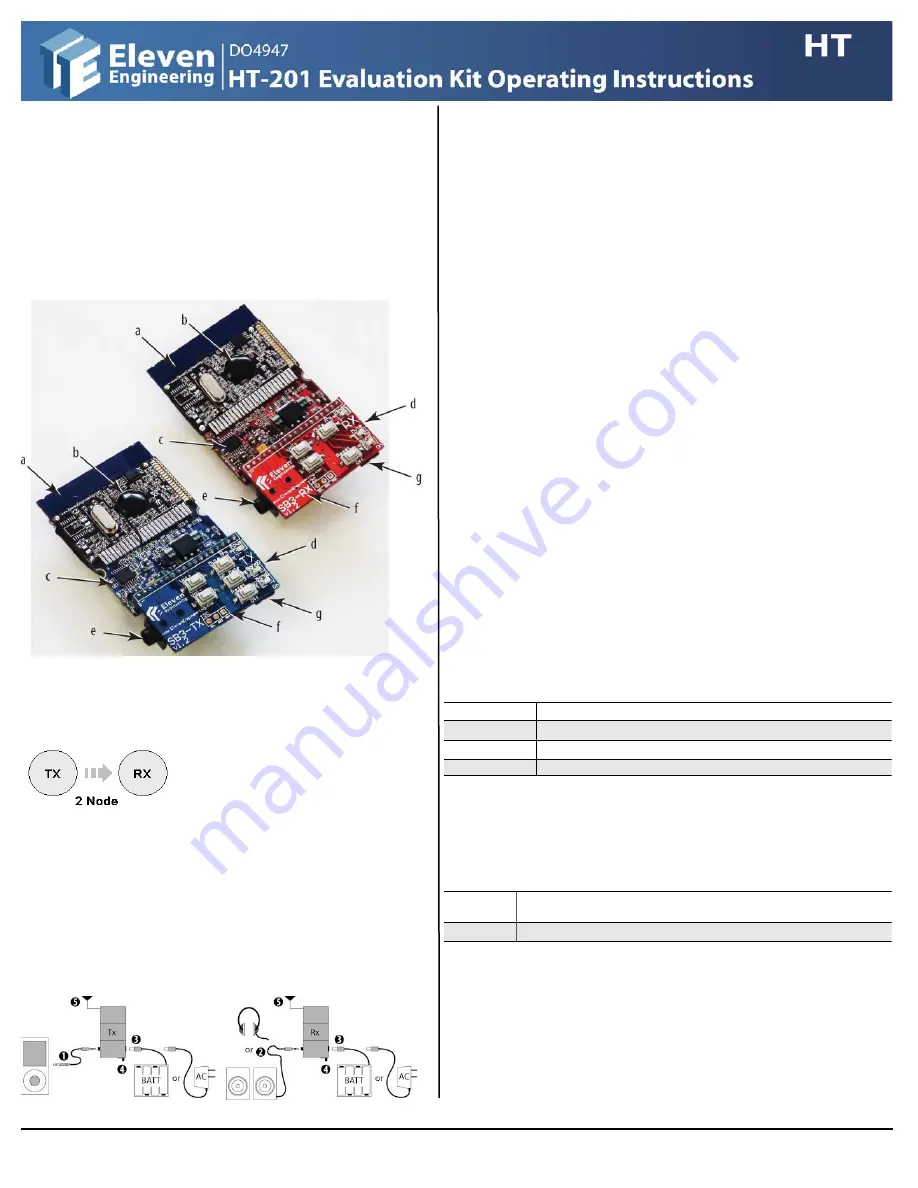
Table of Contents
1. Evaluation Kit Diagram
2. Evaluation Kit Setup
3. Evaluation Kit Features
4. Audio Test Method and Specifications
5. RF Test Method and Specifications
6. Sales and Support
1. Evaluation Kit Diagram
a. Antenna
e. 3.5mm Stereo Audio Jack
b. HT-201 Module
f. SB3 Interface Board
c. PB3 Reference Board
g. Power Switch
d. Power Jack
Your kit is configured as a 2-Node (1 Tx and 1 Rx) system. This kit is a
digital wireless audio 0.1 channel solution.
Audio is on Left Channel only
.
2. Evaluation Kit Setup
This HT-201 Evaluation Kit is pre-assembled and pre-configured to work
out of the box. Follow the simple steps outlined below in order to
correctly setup and begin using the evaluation kit.
1. Plug an audio cable into the audio jack on the Transmitter (Tx). Connect the
other end of the audio cable to an audio source, such as a portable media
player (Maximum input level is -3.5dBV).
2. Plug an audio cable into the audio jack on the Receiver (Rx). Connect the
other end of the cable to an audio amplifier, active speaker, or headphones.*
3. Connect the battery pack or AC adaptor (6V DC, 400mA) to the power jack on
the Tx and Rx.
4. Turn the power switches on both nodes to "on".
5. Make sure that antennas are in free space for best range, i.e. not resting
against a surface, PCB, or body.
Audio signals will begin transmission after step 4.
Please note that because this evaluation kit is electrostatic sensitive, it is
important to keep the Tx and Rx on electrostatic free surfaces.
*Headphones can be used for testing but since no headphone driver is included on the PB3 Rx board, the maximum
volume level may be lower than desired.
3. Evaluation Kit Features
The HT-201 system comes preloaded with application firmware called “Standard
Application”. This application firmware implements a number of useful user
interface features such as LED blinking and push button volume control. It also
supports customizable settings which can be loaded into the modules over Two
Wire Serial Interface (TWSI) or via the XPD programming interface. These
settings are stored in a “Parameter Page” which is a file stored in non-volatile
memory on the HT-201 module. This section provides a brief summary of some
commonly used features of the Standard Application. For a full description refer
to the document “Interfacing to WHAM2 Standard Application” (Available from
Eleven Engineering).
A. Bond LED:
The Bond LED displays the bond status between the Tx node
and the Rx node, as follows:
Solid On
Tx and Rx are bonded.
Flashing (Slow)
Node is searching for bond with its mate.
Flashing (Quick)
Tx is searching to bond with a new mate – Tx ONLY
Off
Board is powered off.
In 2-Node mode, Bond0 will start to flash when the Tx is powered on. The Rx
that bonds to the Tx will cause the Bond0 LED to turn solid green.
B. Mute LED:
The Mute LED displays the audio status of the Rx node, as
follows:
Solid On
Audio is automatically muted due to RF interference OR audio is manually
muted by User OR Rx is searching for bond
Off
Audio can play normally
C. Volume / Mute Control:
Volume control is setup by default in
“Global” mode meaning volume/mute can be adjusted from any node of the
system and all nodes share the same global settings. Other volume modes can
be setup using the parameter page.
Volume buttons on the Tx and Rx will increase/decrease the volume audio level
by 1dB per button press for a total of 70 steps. Pressing and holding a volume
button will ramp the volume quickly. Maximum volume is 0dB and minimum
www.ElevenEngineering.com
Subject to change without notice.
DO4947|
2009.11.05
@2009 Eleven Engineering Inc. XInC
TM
, XInC2
TM
and their associated logos are trademarks
of Eleven Engineering Inc. Multiple Patents and Patents Pending. Other logos, designs, titles
or phrases may be trademarks of Eleven or other entities.






















